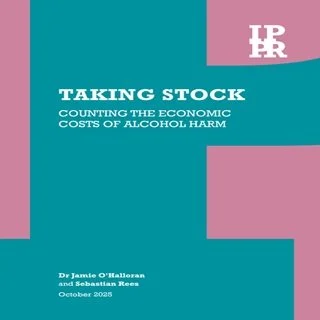By Jamie O’Halloran and Sebastian Rees
Most people are aware of the health risks of drinking alcohol. Alcohol is known to cause at least seven types of cancer and to be a primary risk factor for more than 30 health conditions. The more alcohol someone drinks, the greater the risk. Despite this, alcohol consumption across the UK remains worryingly high.
The most important fact in this report is that after some years when alcohol consumption was going down in the UK, the trend is now heading in the wrong direction and the health risks are clear. Increased rates of alcohol consumption can already be detected in the rise in both alcohol-related and alcohol-specific mortality since 2019. For example, in 2023, 10,473 people died from alcohol-specific causes in the UK, the highest number on record.
Inequalities
As well as having a deleterious effect on the nation’s health as a whole, harmful levels of alcohol consumption are also a key driver of health inequalities. The health burden of alcohol harm is not spread equally across the UK – people living in Scotland, Northern Ireland and Wales are more likely to die of alcohol-specific causes than those living in England.
Impact on the workforce
Leaving aside, for the moment, the impact of people developing onset of chronic health conditions such as cancer, cardiovascular disease and anxiety and depression, which often lead to people leaving the labour market, alcohol consumption also has significant effects on the productivity of those in work. It can increase both:
absenteeism, where people take time off due to illness and
presenteeism, where people are at work but their capacity is reduced.
Previous analysis by the Institute of Alcohol Studies estimates that alcohol consumption costs the economy £5.06 billion a year – with 44 per cent of the cost being due to presenteeism.
The current report builds on existing analysis and takes a closer look at the relationship between alcohol consumption and workforce productivity by using data from Understanding Society – a large longitudinal panel survey of UK households – and findings from a specially commissioned survey, the authors examine alcohol’s economic impact more deeply, including its varied impacts on different sectors of the economy and job roles.
Key findings
A quarter of employees feel pressure to drink at workplace events, rising to 38 per cent of 18 to 24 year olds
Workplace drinking culture driving absences as 31 per cent of workers call in sick in past year after work events
IPPR calls for minimum unit pricing, reintroducing the alcohol duty escalator, and stronger action from employers
The authors say that pressure to drink at work events is contributing to widespread alcohol-related absences and reduced productivity across all sectors.
From after-work drinks to subsidised bar tabs at company events, alcohol is often embedded in professional life. A quarter (24 per cent) of workers said they sometimes felt pressured to drink when they didn’t want to, rising to 38 per cent among younger employees (aged 18-24). Over a third said drinking at work events excluded non-drinkers or created cliques.
This culture is driving real consequences. One in three UK workers (31 per cent) have called in sick in the past year after drinking at work-related events, while 22 per cent reported working while hungover, and 29 per cent observed colleagues being tired or sluggish after drinking.
Interestingly, young workers and senior executives are among the most affected groups.
London: IPPR, the Institute for Public Policy Research, i2025. 30p.




